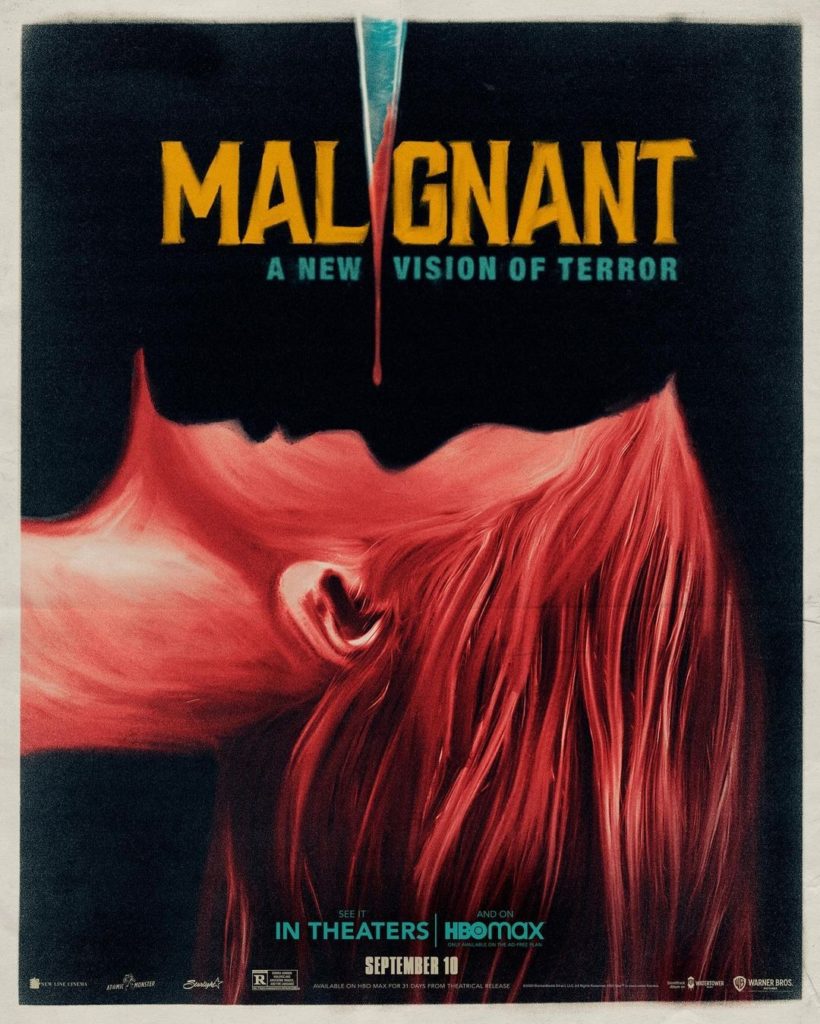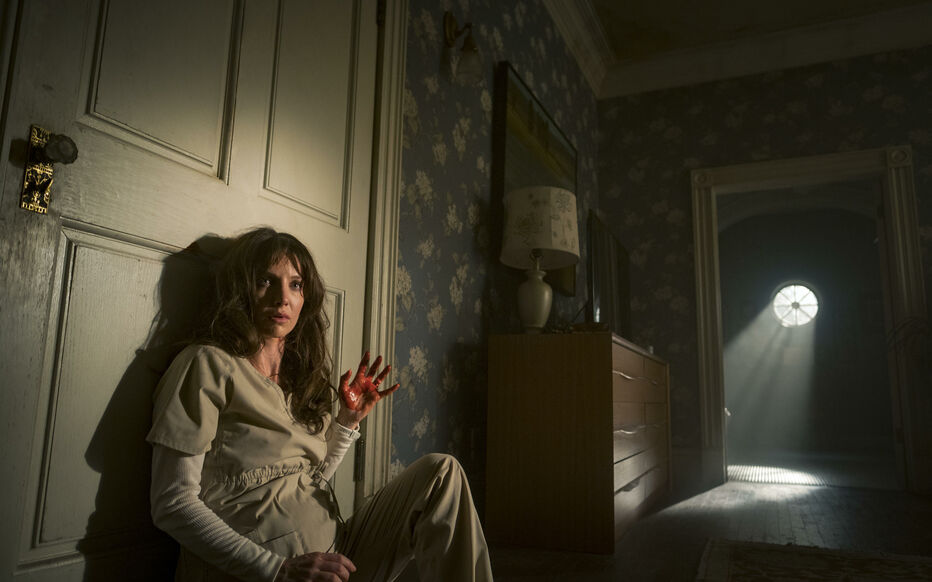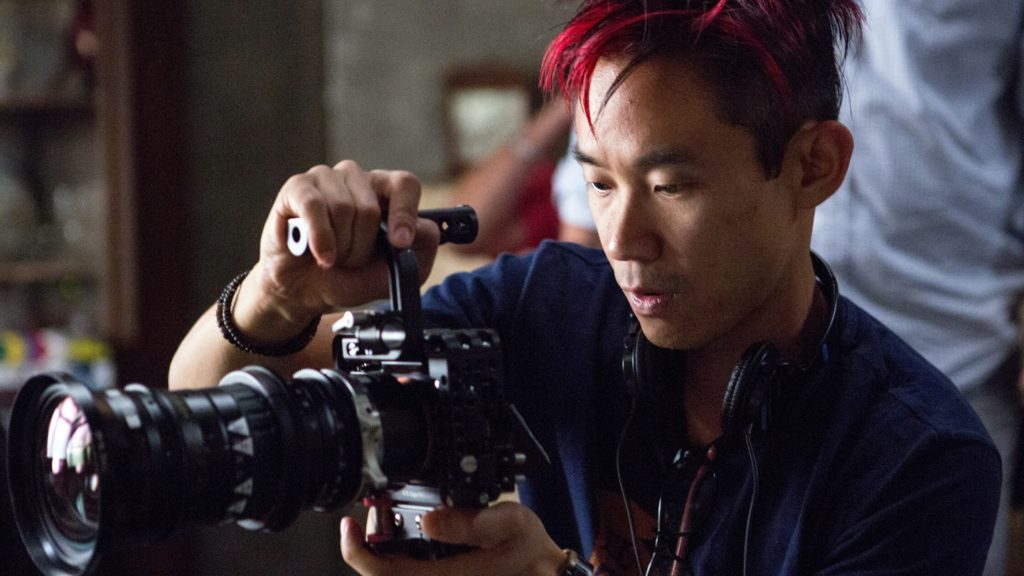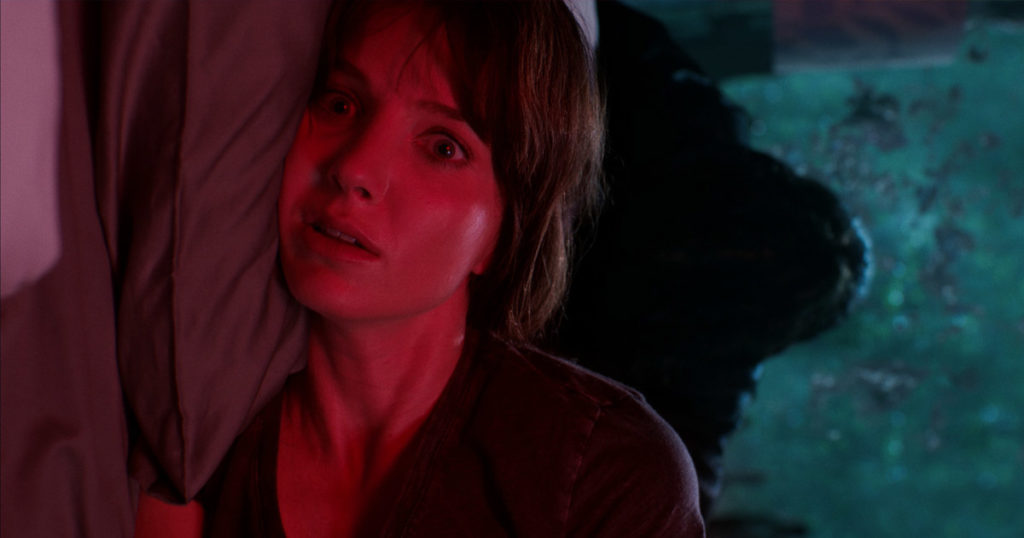温子仁在指导了大片《海王》(他很快就会携第二部回归)和《速度与激情》的重力挑战赛之后,终于重回恐怖片的老本行。对于这部夹在大型特许经营项目之间的电影来说,最令人惊讶的并不是温子仁成功地找到了一个不祥的形容词作为电影名称,或者另一个充满恐惧感的吱吱作响的房子,而是他回归粗暴的B级电影时并没有失去他的优势或对恐怖电影制作的能力。尽管这部电影可能不如它所宣称的那样,是“恐怖片的一个新视角”,但其故事对恐怖片的陈词滥调进行了巧妙的再创作。
影片开始于1993年,在一家令人毛骨悚然的医院–Simion研究机构中。儿童外科专家Weaver医生详细介绍了她治疗 Gabriel的经验, Gabriel是一个失去控制的具有掌控电力能力的畸形病人(这对温子仁来说是一个完美的机会,可以让所有的灯光随意闪烁和爆炸)。在老式录像机的录音中,医生Weaver决定是时候 “切除癌症 “了。
随后画面切换到现在:在西雅图,我们怀孕的主人公麦迪(Annabelle Wallis扮演,她凭借《浴血黑帮》中的角色而扬名)回到了家里,她的丈夫对她施暴,将她的头撞向墙壁。在不剧透其他细节的情况下,我只想说发生了一起可怕的谋杀案。此后不久麦迪开始饱受幻觉的困扰,幻觉中满是一个身穿皮风衣的高个子男子所犯下的杀戮行为。当然,所有的这些杀人事件都与电影的序幕有关。
影片的开头看起来很笨拙,因为我们不知道发生了什么,也不知道为什么,我们没有理由去关心我们的主人公麦迪、她的妹妹悉尼,或者发生在她们身上的任何事情。一切似乎都很平庸甚至有廉价感,从我们的主人公戴的糟糕的黑色假发到超自然杀手的无定形的身体,感觉就像在看一部通过肮脏的镜子录下的恐怖片的精华部分剪辑的VHS录像带。肥皂剧式的演技,轻微的恐怖氛围。但是随着情节的发展,我们意识到这可能是导演有意为之的:这一次,糟糕的假发和形状怪异的身体是剧本的一个特点,而并非懒惰的电影制作的产物。这一起都在为一个史诗般的转折做准备,而我们则在一旁观看着。
当温子仁从恐怖片转向超级英雄时,看起来可能感觉奇怪(是的,《速度与激情》如果不是因为创造了以汽油为动力的超级生物就什么都不是),但事后看来可以理解。这位导演擅长将其恐怖片神话化和扩大化,创造精心设计的背景故事和多部续集的可能性,正如在《招魂》和《潜伏》系列中看到的那样。 《致命感应》遵循这一趋势,强调了反派的背景故事。因为在现代恐怖片中,坏人必须有理由变坏,他们不能只是纯粹的、无法解释的邪恶。
这次有趣的是,《致命感应》力求做到“解释”,而不是“刺激”。没有错,本片的拍摄效果很好。温子仁利用了他所掌握的所有工具,从慢速变焦到长焦技术的使用,以及他将受害者安置在破旧的老房子里的地理选择。然而,这部影片是一种反恐怖片:在大多数恐怖片中,我们被表演的过程所吸引,无论是杀戮还是跳楼的惊吓,但最终却对故事给我们的答案感到失望。然而《致命感应》并不十分可怕,但它所提供的答案却是巧妙的,而且,我敢说是很新颖的。
温子仁在2004年以《电锯惊魂》开始了现代恐怖片的革命,但《致命感应》并不是这样的惊喜之作。作为一个纯粹的恐怖片,《致命感应》是一个有瑕疵的作品。作为对恐怖片的解构,它扮演的是一个时而可笑但同样聪明的角色,并向之前的电影致敬,仿佛导演不确定是要让观众笑还是要让他们吓得发抖。当转折点落下,第三幕呈现出疯狂、血腥的结局时,我看得很开心。离开放映厅时,我确信了一件事:这部电影可能是愚蠢的,但它并没有侮辱我的智商。
影评人简介

贝尔纳多·莱特(Bernardo Leyte),常驻巴黎的电影制作人。 他在西班牙、德国和英国长大,毕业于伦敦电影学院,目前担任导演。 他是一位充满热情的影迷,他所观看的电影囊括各种类型,从他的偶像斯坦利·库布里克(Stanley Kubrick)和安德烈·塔可夫斯基(Andrei Tarkovsky)的電影,到超级英雄、恐怖片、动漫等。
Original text

Malignant is director James Wan’s return to horror, his genre of origin, after a stint in the higher profile waters of Aquaman (to which he will soon return) and the gravity-defying races of Fast and the Furious. For this film, sandwiched between big franchise entries, what is most surprising isn’t the fact that Wan has managed to find yet another ominous adjective for a movie title, or another creaky house to fill with dread, but the fact that his return to campy, B-movie thrills sees him unchanged, having lost none of his edge or genre filmmaking chops. Though the film may be less than it claims to be (“a new vision of terror”, says the tagline), its derivate story builds to a clever reworking of the tropes within it.
The film begins in the year 1993, in an appropriately creepy hospital, the Simion research facility, where doctor Weaver, a children’s reconstructive surgery expert, details her experience with Gabriel, a deformed patient with the ability to hijack electricity (a perfect opportunity for Wan to make all the lights flicker and explode at will) who is out of control. In the old VHS recording, doctor Weaver decides it is time to “cut out the cancer”.
Cut to the present: in Seattle, our pregnant protagonist, Maddie Mitchel, played by Annabelle Wallis (who is perhaps best known for her work in Peaky Blinders), comes back home to her abusive husband, who promptly knocks her head against a wall. Without spoiling the rest of the details, suffice it to say that a grisly murder takes place, and soon thereafter Maddie becomes possessed by visions of killings perpetrated by a tall, gangly creature in a leather trench-coat; of course, all these killings are connected to the prologue.
The film starts out clumsily, as we don’t know what is happening or why, and we are given no reason to care about our protagonist Maddie, her sister Sydney, or any of the things that happen to them. Everything seems derivative, even cheap, from the bad black wig worn by our protagonist to the amorphously shaped body of the supernatural killer. It feels like watching a VHS of a greatest hits supercut of all the horror films that have ever existed, recorded through a dirty mirror. The acting is soapy, the scares are slight. But, as the plot develops, we realize that this may be intentional: for once, the bad wigs and the weirdly shaped bodies of the monsters are a feature of the script, and not a product of lazy filmmaking. The film is building to an epic twist, and we are along for the ride.
James Wan may have seemed a strange fit when he moved from horror to superheroes (yes, the Fast and the Furious family is nothing if not gasoline-powered super-beings), but in hindsight, it makes a lot of sense; the director has a knack for mythologizing and expanding his horror films, creating contrived backstories and the possibility for multiple sequels, as seen in the Conjuring and Insidious franchises. Malignant follows this trend by emphasising on the backstory of its antagonist because in modern horror, there has to be reason for the bad guy to be bad, they cannot just be pure, unexplained evil.
What is interesting this time is that Malignant’s raison d’etre IS the explanation, and not the thrills. Make no mistake, the filmmaking on display is good. Wan utilises all the tools at his disposal, from the use of slow zoom-ins to long focus techniques, and the geographical control of the architecture of the creaky old houses he puts his victims in. However, this film is a kind of anti-horror: in most scary movies, we are entertained by the execution, be it the kills or the jump scares, but ultimately left disappointed by the answers the story gives us. Malignant, on the other hand, is not very scary, and yet the answers it provides are ingenious and, dare I say it, original.
James Wan started the revolution of modern horror films in 2004 with Saw, but Malignant is no such surprise hit. As a pure horror, Malignant is a flawed creation. As a deconstruction of horror, it plays as a sometimes ridiculous, but equally clever, homage to the films that came before, as if the director wasn’t sure whether to make the audience laugh or shiver in terror. By the time the twist dropped, and the third act delivered its mad, bloody finale, I was having a great time and left the screening convinced of one thing: this film may be stupid, but it is not an insult to my intelligence.
About the author

Bernardo Leyte (Vigo, Spain) is a Paris-based filmmaker. He grew up in Spain, Germany and the UK, graduating as a director from the London Film School. He is a passionate cinephile whose eclectic film playlist includes a bit of everything, from his idols, Kubrick and Tarkovsky, to superheroes, horror, anime and everything in between.




